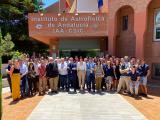Archivo de noticias y eventos
351 - 400 de un total de 2404
También puede acceder a la lista de noticias publicadas en los medios relacionadas con el Instituto de Astrofísica de Andalucía - CSIC.
Pages
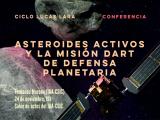
|
24/11/2022 - 19:00
Asteroides activos y la misión DART de defensa planetaria Conferencia de divulgación sobre los asteroides activos, que muestran rasgos tanto de asteroide como de cometa Fernando Moreno |

|
12/01/2023 - 12:30
CARMENES-PLUS: a technical upgrade for CARMENES and the impact on its science CARMENES is a dual (VIS: 550 to 950 nm; NIR: 950 to 1700 nm) high-resolution spectrograph installed at the 3.5 m telescope at the Calar Alto Observatory (CAHA, Almería, Spain). The NIR channel spectrograph uses the radial-velocity method for detecting exoplanets around low-mass stars. Thus, a high thermal stability is required in the NIR cooling system to achieve a high precision in radial velocities. The cooling system was originally conceived... Roberto Varas González |

|
25/05/2023 - 12:30
SO colloquio: To be black, or not? Observational tests of strong field gravity are improving rapidly. This allows us to test whether the compact objects observed in the sky are truly black holes as described in general relativity or some other "exotic" objects. These tests, however, require exquisite theoretical modeling of black holes as well as their alternatives. This talk will discuss two such examples: the impact of the astrophysical environment on black holes and the... Dr. Béatrice Bonga |
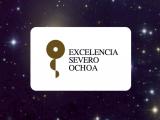
|
08/11/2022
El Instituto de Astrofísica de Andalucía (IAA-CSIC) consigue por segunda vez el distintivo de Centro de Excelencia Severo Ochoa El distintivo, que dota a los centros con un millón de euros anual durante cuatro años, tiene como objetivo financiar y acreditar a las instituciones que demuestran impacto y liderazgo a nivel internacional |
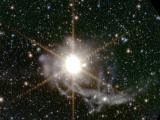
|
03/11/2022
El IAA-CSIC participa en ARRAKIHS, la misión de la Agencia Espacial Europea para el estudio de la materia oscura Se trata de la primera misión del Programa Científico de la ESA coordinada por España. El IAA-CSIC llevará a cabo la coordinación de la estrategia observacional de la misión |
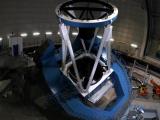
|
26/10/2022
Comienza la construcción de TARSIS, el instrumento de próxima generación para el telescopio de 3.5 metros de Calar Alto TARSIS presenta características únicas, en particular su capacidad para detectar luz en el ultravioleta cercano y su campo de visión sin precedentes |

|
24/11/2022 - 12:30
SO webloquio: The Milky Way Nuclear Star Cluster The Milky Way nuclear star cluster (NSC) is located within the nuclear stellar disc (NSD) in the Galactic centre. The NSC and NSD are distinct structures of the Milky Way, but also connected to the larger Milky Way structures, e.g. via the inflow and outflow of gas, and the infall of star clusters. Our knowledge of the larger Milky Way structures, Galactic disc, bulge and halo, has expanded in recent years through surveys and dedicated missions... Dr. Anja Feldmeier |

|
07/11/2022 - 12:30
The ASTRI Mini-Array and its Science The ASTRI Collaboration is building at the Teide Astronomical Observatory in Tenerife an array of 9 small Cherenkov telescopes capable of observing with good flux sensitivity, energy and angular resolution the gamma-ray sky above an energy threshold of several hundreds of GeV. The ASTRI telescopes adopt a dual-mirror Schwarzschild-Couder optical design. Entrapped amidst the two mirrors the ASTRI camera, based on silicon photon-multipliers... Dr. Giacomo Bonnoli |

|
29/11/2022 - 12:30
TARSIS: the Tetra-Armed IFU at Calar Alto designed for the CATARSIS galaxy cluster exploration In this talk I will present the design of the Integral Field Unit TARSIS, recently selected to be the next generation multi-object spectrograph for the 3.5m telescope at Calar Alto. In addition, I will describe the scientific goals of CATARSIS, the galaxy cluster exploration that will be carried out in the first years of the operation of TARSIS. Dr. Jorge Iglesias |

|
15/11/2022 - 12:30
The effect of pre-processing on the stellar population content of early-type dwarf galaxies According to the CDM model, galaxy clusters grow through the accretion of individual galaxies and galaxy groups. Thus, it is a true challenge to distinguish the possible role of the present-day host halo from that of previous ones, in the transformation of accreted galaxies. Dwarf early-type galaxies (dEs) are often regarded as statistically meaningful testbeds for investigating environmental effects mainly due to their high number density and... Dr. Bahar Bidaran |
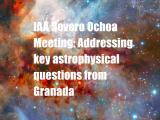
|
13/10/2022
Congreso Severo Ochoa IAA: abordando las cuestiones clave en astrofísica desde Granada El Instituto de Astrofísica de Andalucía (IAA-CSIC) organiza un encuentro con especialistas de todo el mundo sobre los problemas más actuales que afronta la astrofísica |
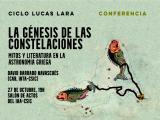
|
27/10/2022 - 19:00
La génesis de las constelaciones. Mitos y literatura en la astronomía griega La esfera celeste se divide en la actualidad en 88 constelaciones. Son agrupaciones aparentes de estrellas que aparecen dibujadas sobre la esfera celeste, en un ejercicio intelectual que mucho tiene que ver con la cultura. Cada civilización ha recreado las constelaciones según sus creencias, aunque las aceptadas por la Unión Astronómica Internacional se basan, sobre todo, en la Era de los Descubrimientos y en la tradición grecorromana.... David Barrado Navascués |
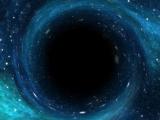
|
10/10/2022
Un estudio apunta a la existencia de estrellas tan compactas como los agujeros negros El Instituto de Astrofísica de Andalucía (IAA-CSIC) encabeza un estudio teórico que muestra que algunos de los objetos catalogados como agujeros negros podrían ser en realidad estrellas ultracompactas |
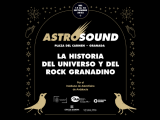
|
15/09/2022
AstroSound 2022 El Instituto de Astrofísica de Andalucía es uno de los mayores centros de referencia en astrofísica y ciencias del espacio a nivel internacional. Además, destaca por su intensa actividad divulgadora; su Unidad de Cultura Científica es una de las más reconocidas de nuestro país, acercando la ciencia a la sociedad a través de formatos rompedores que han sido merecedores de diferentes reconocimientos a lo largo de los últimos años. ASTROSOUND... |

|
06/10/2022
La astronomía del futuro será colaborativa, multionda, más diversa y verde El Instituto de Astrofísica de Andalucía (IAA-CSIC) ha acogido una mesa redonda con los responsables de tres de las mayores infraestructuras astronómicas en Tierra: el Cherenkov Telescope Array Observatory (CTAO), el Telescopio Extremadamente Grande (ELT) y el Square Kilometre Array Observatory (SKAO). El carácter de estas instalaciones, que abrirán nuevas ventanas al cosmos en rayos gamma, en óptico e infrarrojo cercano y en radioastronomía,... |
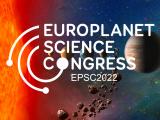
|
20/09/2022
El mayor encuentro europeo sobre ciencias planetarias se celebra en Granada Más de mil especialistas participan en el congreso, organizado a nivel local por miembros del Instituto de Astrofísica de Andalucía (IAA-CSIC) y celebrado en el Palacio de Congresos. Este gran encuentro ha permitido la organización, en el IAA-CSIC, de una reunión con representantes de las agencias espaciales europea y estadounidense (ESA y NASA) sobre las misiones espaciales JUICE (ESA) y Clipper (NASA) |
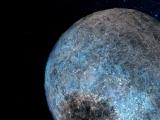
|
08/09/2022
Un estudio revela que los mundos acuáticos podrían ser más comunes de lo esperado El Instituto de Astrofísica de Andalucía (IAA-CSIC) encabeza un estudio que halla evidencias de la existencia de abundantes planetas extrasolares compuestos de hielo y roca alrededor de estrellas enanas |
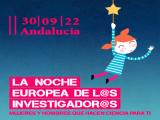
|
06/09/2022
La Noche de l@s Investigador@s 2022 La Noche Europea de l@s Investigador@s se celebra este año el 30 de septiembre en las ocho capitales andaluzas y nosotros te invitamos a Granada a celebrar con nosotr@s en el Stand del IAA-CSIC. |
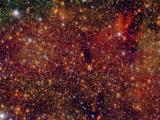
|
25/08/2022
Primer vistazo a la prolífica fábrica estelar del centro de la Vía Láctea Un estudio, enmarcado en el proyecto GALACTICNUCLEUS, coordinado por el Instituto de Astrofísica de Andalucía (IAA-CSIC), revela la historia de formación estelar del centro de nuestra galaxia |
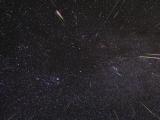
|
08/08/2022
Llega la lluvia de estrellas de las perseidas Se producen por el impacto en nuestra atmósfera de fragmentos de la nube de meteoroides del cometa 109P/Swift-Tuttle. Durante el máximo, entre el 11 y el 13 de agosto, podrán observarse hasta cincuenta perseidas por hora en lugares alejados de la contaminación lumínica |

|
02/08/2022
El Proyecto AMANAR visita Calar Alto Doce niños de la Asociación Granadina de Amistad con la República Árabe Saharaui Democrática han disfrutado de las instalaciones del observatorio andaluz |

|
19/12/2022 - 12:30
Fossil groups of galaxies: seeing the future looking at the past The nature of fossil groups of galaxies has been debated for over more than 3 decades. This is in part because of the lack of deep multiwavelength data and also due to the low purity of samples selected using solely magnitude gap criteria. The initial results of a sample of bonafide fossil groups using X-ray/optical observations has clarified many of their characteristics, such as high central metal abundances and concentration measurements.... Dr. Renato Dupke |

|
01/12/2022 - 12:30
SO Colloquio: Moving from high to extreme precision in air shower observations: From LOFAR to SKAO Cosmic rays play an interesting role in understanding the most violent objects in the universe. These charged atomic particles reach energies orders of magnitudes higher than achievable in accelerators on Earth, which points towards an origin of the most extreme objects in the universe, with strong magnetic shocks and mass transfer. However, these sources are not firmly identified. Astrophysical interpretations are currently limited by the... Dr. Anna Nelles |

|
17/11/2022 - 12:30
SO colloquio: A conclusive test of the cold dark matter model The ``Lambda cold dark matter'' (LCDM) cosmological model is one of the great achievements in Physics of the past thirty years. Theoretical predictions formulated in the 1980s turned out to agree remarkably well with measurements, performed decades later, of the galaxy distribution and the temperature structure of the cosmic microwave background radiation. Yet, these successes do not inform us directly about the nature of the dark matter. This... Dr. Carlos Frenk |

|
08/11/2022 - 12:30
The many “phases” of small bodies Asteroids, comets, and trans-Neptunian objects are collectively known as small bodies. In a way, they are the debris left by the planetary formation in the Solar system, and as such, they carry a lot of information regarding the processes that shaped it. But, small bodies are by no means stationary objects: not only do they move across the sky, but their brightness also changes due to different mechanisms, from rotational variations due to... Dr. Álvaro Alvarez-Candal |

|
25/10/2022 - 12:30
SO Colloquio: Galactic Center: Radiation from black hole candidates and the dynamics of high velocity stars We summarize recent research results on the radiation mechanism of the Super Massive Black Hole (SMBH) candidate SgrA* and ask the question if there are Intermediate Mass Black Hole (IMBH) candidates in the central stellar cluster. Furthermore we give an update on the most recent high velocity stars in the central arcsecond - that are closest to SgrA*. Here we concentrate on the high velocity star cluster dynamics and on the 4711+ stars with... Prof. Andreas Eckart |

|
26/09/2022 - 12:30
The EnVision mission to Venus: Discovering why our closest neighbour is so different EnVision was selected as ESA’s 5th Medium-class mission in the Agency’s Cosmic Vision plan, targeting a launch in the early 2030s. The mission is a partnership between ESA and NASA. The primary goal is to provide a holistic view of Venus, from its inner core up to its upper atmosphere by a single mission, and will be the first mission of its kind. More specifically, EnVision will characterise Venus’ core and mantle structure, in order to study... Dr. Anne Grete Straume |

|
13/09/2022 - 12:30
SO Colloquio: Studies on the origins of our solar system My goal in this colloquium is to apprehend globally the Solar System by describing a vast sample of small bodies, from Near Earth Asteroids to remote Trans-Neptunian Objects. This goes beyond projects that focused on certain populations only. The core of the talk is theoretical, with emphasis on inner structures and rings. Meanwhile, the stellar occultations by these objects will provide an exploratory route to characterize objects with widely... Dr. Bruno Sicardy |

|
07/07/2022
Se halla un posible fósil galáctico en las cercanías de Andrómeda Una inusual galaxia enana ultradébil ha sido descubierta, en el marco de un proyecto encabezado por el Instituto de Astrofísica de Andalucía (IAA-CSIC), en los límites exteriores de la galaxia de Andrómeda. Denominada Pegasus V, contiene muy pocos elementos pesados y es probable que sea un fósil de las primeras galaxias |
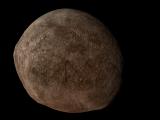
|
29/06/2022
Una campaña sin precedentes para caracterizar el transneptuniano Huya Se publican los resultados de la ocultación estelar por un objeto transneptuniano con mayor número de detecciones hasta la fecha. El trabajo, liderado por el IAA-CSIC, ofrece la mejor caracterización física del TNO Huya a día de hoy. |
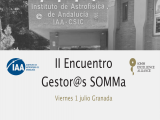
|
29/06/2022
El Instituto de Astrofísica de Andalucía acoge el II Encuentro de Gestor@s de la alianza de centros Severo Ochoa y unidades María de Maeztu, SOMMa. Este viernes 1 de julio tendrá lugar en el Instituto de Astrofísica de Andalucía (IAA-CSIC) el II Encuentro de Gestor@s de la alianza SOMMa. Esta alianza reúne a los Centros de Excelencia Severo Ochoa y Unidades de María de Maeztu acreditadas con este sello, que otorga el Ministerio de Ciencia e Innovación a aquellos centros y unidades de investigación que destacan por su relevancia e impacto a nivel internacional. |

|
27/06/2022
El IAA participa en la Semana de la Administración Abierta El IAA-CSIC, a través de varias iniciativas lideradas por el grupo de SKA en España, participa en la Semana de la Administración Abierta |
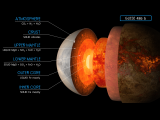
|
21/06/2022
La supertierra mejor estudiada hasta la fecha Un equipo científico internacional con participación del Instituto de Astrofísica de Andalucía (IAA-CSIC), ha medido con una precisión sin precedentes la masa y el radio de Gliese 486 b, un exoplaneta de tipo “supertierra”, descubierto en el 2021 con el instrumento CARMENES del observatorio de Calar Alto. |

|
06/10/2022 - 12:30
Computational Intelligence in the Big Data Context Computational Intelligence (CI) commonly refers to a variety of bio-inspired and/or human-like techniques that can be applied in optimisation, learning and modelling problems. Broadly speaking, CI comprises Artificial Neural Networks, Fuzzy Sets and Fuzzy Logic and Evolutionary Computation. In the era of big data, CI in conjunction with data mining techniques are expected to help uncover useful knowledge from big data as they are very well... Dr. Isaac Triguero |

|
13/10/2022 - 12:30
New developments at the IAA cosmic dust laboratory The interpretation of astronomical observations of comets and asteroids and of extrasolar objects such as protoplanetary and debris disks is crucial for understanding the origin and evolution of planetary systems. Collecting electromagnetic radiation scattered or emitted by dust particles present in these objects with powerful telescopes is often our only way to observe and characterized them. In situ observations are available for a handful of... Dr. Juan Carlos Gómez |
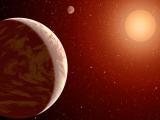
|
15/06/2022
Detectados dos exoplanetas rocosos y calientes transitando una estrella cercana Un equipo internacional liderado por el Instituto de Astrofísica de Andalucía (IAA-CSIC), ha detectado dos planetas telúricos orbitando la estrella cercana HD 260655. |
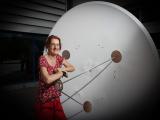
|
03/06/2022
La investigadora del IAA-CSIC, Lourdes Verdes-Montenegro, gana el premio Ada Byron de la Universidad de Deusto La granadina Lourdes Verdes-Montenegro ha sido la ganadora de la novena edición del Premio Ada Byron a la Mujer Tecnóloga, organizado por la Facultad de Ingeniería de la Universidad de Deusto. |
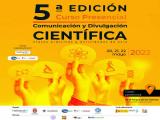
|
20/05/2022 - 22/05/2022
COURSE ON DISSEMINATION TECHNIQUES. RECREATIONAL AND TRAINING DAYS "Practical classes and leisure activities". Granada |

|
13/06/2024 - 12:30
SO colloquium: The magnetised intergalactic medium revealed by SKA Pathfinders Using broadband radio polarimetry we can probe regions of diffuse ionised and magnetised gas that are challenging to detect by other means, such as in the halos of galaxies (CGM), in galaxy groups and clusters (IGrM/ICM), and filaments of the cosmic web (ie. WHIM). Here I will highlight recent results from the LOFAR and ASKAP radio telescopes,which use the effect of Faraday rotation to illuminate the CGM, IGrM, ICM and WHIM gas. In particular, I... Dr. Shane O'Sullivan |

|
10/11/2022 - 12:30
SO Colloquio: The Cherenkov Telescope Array: Status and Prospects The Cherenkov Telescope Array (CTA) will become the reference observatory for Very High Energy (VHE) Gamma Ray Astronomy during the next decades. CTA promises a jump in sensitivity and energy coverage of one order of magnitude over the current instruments, significantly improved energy and angular resolutions and full sky coverage. Over thousand new sources will foreseeably be identified in this range for the first time. VHE gamma rays are... Dr. Juan Cortina |
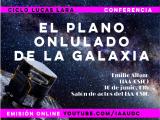
|
30/06/2022 - 19:00
El plano ondulado de la galaxia Conferencia sobre la Vía Láctea, la galaxia que alberga el Sistema Solar Emilio J. Alfaro |
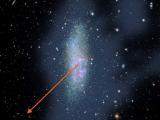
|
25/05/2022
Una galaxia enana aislada, inesperadamente afectada por su entorno El hallazgo, que cuenta con la participación del IAA-CSIC, fuerza un cambio en la concepción de las galaxias aisladas |
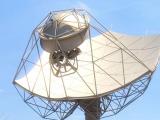
|
25/05/2022
El Ministerio de Ciencia e Innovación destina 2,5 millones de euros al radiotelescopio internacional Square Kilometre Array El Square Kilometre Array (SKA) permitirá avanzar en la búsqueda de signos de vida en la galaxia y en la observación de púlsares, agujeros negros y ondas gravitacionales. La coordinación técnica de la participación española en el proyecto corre a cargo del Instituto de Astrofísica de Andalucía (IAA-CSIC) |
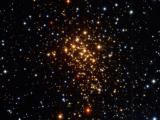
|
25/05/2022
El cúmulo Westerlund 1: un vivero de estrellas gigantes que emerge de las tinieblas El Instituto de Astrofísica de Andalucía (IAA-CSIC) participa en el estudio del cúmulo joven de estrellas más masivo de la Vía Láctea. Este enjambre estelar aglutina distintos tipos de estrellas gigantes en diversas fases evolutivas, y constituye un laboratorio de primer nivel para el estudio de la formación y evolución de las estrellas masivas |

|
24/05/2022
La delegación de Educación, la UGR y el CSIC inauguran el X Congreso del Proyecto de Iniciación a la Investigación e Innovación en Secundaria en Granada Más de 300 estudiantes de 52 institutos de Secundaria de toda la provincia han participado en experiencias reales de investigación en centros del CSIC y la UGR |
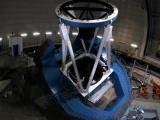
|
24/05/2022
TARSIS, el instrumento de próxima generación para el telescopio de 3,5 metros de Calar Alto La UCM y el IAA-CSIC colideran TARSIS, el futuro instrumento del telescopio de 3,5 m de Calar Alto. TARSIS tiene características únicas, en particular su capacidad para detectar luz en el ultravioleta cercano y su campo de visión sin precedentes |

|
28/10/2022 - 12:30
SO Colloquio: Cosmografía: las aportaciones de al-Ándalus y los reinos ibéricos a la Revolución Científica Si el Señor Todopoderoso me hubiese consultado, antes de embarcarse en la Creación, le habría recomendado algo más simple. Esta frase, supuestamente formulada por Alfonso X "el Sabio", muestra la complejidad del conocimiento cosmográfico en al-Ándalus y en los reinos cristianos que recibieron su acervo científico. La península Ibérica se convirtió a partir del siglo X en puente esencial para que el saber de la civilización grecorromana,... Dr David Barrado Navascués |

|
19/05/2022
La investigadora del IAA-CSIC Josefa Masegosa, premio Mariana Pineda de Igualdad 2020 El Premio Mariana Pineda a la Igualdad entre Mujeres y Hombres tiene la finalidad de otorgar reconocimiento público a la labor desarrollada por personas o entidades que hayan contribuido y destacado en la promoción de la igualdad |

